Hershey, Pennsylvania – Wednesday, June 11th, 2008
We arrived at Hersheypark with just enough time to get a bite to eat at a Red Robin behind the park near Lightning Racer before getting in for the free preview night starting at 7:30. Says the lady at the ticket counter,
“You sure you want to use this now, it’s getting pretty late already…”
Just as she’s halfway through ripping the stub off my Dutch Wonderland/Hersheypark combo ticket I bought earlier today, I stop her and point out a second time that we’re here for the preview night. Unsure of herself, she calls over a supervisor who confirms for us that, yes, we are entitled to one preview night on the combo ticket. She takes out a big marker and writes “NOT VOID” on my half ripped ticket and returns it to me, then lets me and my dad pass.
then lets me and my dad pass.
The park was displaying healthy crowds for a Wednesday evening, and yet it was clear that none of the lines would be unmanageable. First up is The Comet, which is nearly an essential first roller coaster ride of any visit to Hersheypark. I’m always torn about my feelings for The Comet. On the one hand, it’s a classic with a unique T design layout, and the park always does an impeccable job at keeping it clean and polished looking, like it’s still a signature attraction to be advertised front and center rather than an old relic they keep around in a back corner of the park just for niche appeal (Dorney Park’s Thunderhawk, Cedar Point’s Blue Streak, etc.) On the other hand, it just doesn’t appropriate it’s speed very well,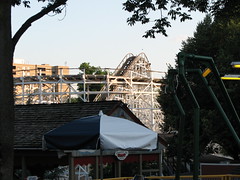 and the ride goes from feeling like it’s just getting started in the first half, to just wrapping up in the second half. The first two drops are nice and deep, but they’re not used for much else than a fast pullout. There’s one fast middle hill before the second turnaround, which is too drawn out over it’s peak to again result in anything other than fast pullouts mirrored on either sides with languid interludes. After the second turnaround it promptly looses all it’s speed and height it did at least have going for it in the first half, and goes straight to focusing on the decent if not slightly un-sprightly leg of the T-run… all before a satisfactory answer to the first half had ever really been given. I guess my problem with the second half is that it lacks good airtime. I qualify ‘good airtime’ instead of ‘no airtime’ because it is there, it just isn’t the
and the ride goes from feeling like it’s just getting started in the first half, to just wrapping up in the second half. The first two drops are nice and deep, but they’re not used for much else than a fast pullout. There’s one fast middle hill before the second turnaround, which is too drawn out over it’s peak to again result in anything other than fast pullouts mirrored on either sides with languid interludes. After the second turnaround it promptly looses all it’s speed and height it did at least have going for it in the first half, and goes straight to focusing on the decent if not slightly un-sprightly leg of the T-run… all before a satisfactory answer to the first half had ever really been given. I guess my problem with the second half is that it lacks good airtime. I qualify ‘good airtime’ instead of ‘no airtime’ because it is there, it just isn’t the 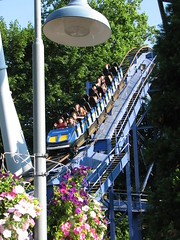 first or even second thing I notice about this part of the ride, compared to some other outstanding classic wooden coasters. Well, I really can’t complain too much, since it is a classic, and I personally have always felt that trying to analyze and critique them as one would with a modern wooden coasters is ultimately missing the point, especially when they’re still as well-preserved to their original form as The Comet is.
first or even second thing I notice about this part of the ride, compared to some other outstanding classic wooden coasters. Well, I really can’t complain too much, since it is a classic, and I personally have always felt that trying to analyze and critique them as one would with a modern wooden coasters is ultimately missing the point, especially when they’re still as well-preserved to their original form as The Comet is.
Speaking of well-preserved classics, hidden at the end of the Comet Hollow midway is our next ride, Sooperdooperlooper. Unlike the Comet, which had a 10 minute wait or so, Sooperdooperlooper was a walk-on for nearly every seat except the front. Like the Comet, I also wouldn’t say that this was one of Schwarzkopf’s better looping designs at the time, forgoing the unique terrain S-curve dives and long build-up into the looping centerpiece found on Magic Mountain’s Revolution, instead starting off with a fast drop right into the loop, and then spending the rest of the ride behaving as a mine train running next to the riverside. And that really doesn’t matter here, either, because it has so much retro charm in it I could hardly ask for it any other way.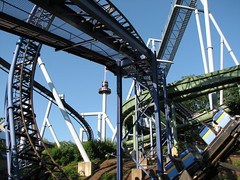
From here we made a quick jump on the Coal Cracker – still one of the nicer flumes around – while on the way to get a ride in on the Great Bear. I think it was somewhere around this area as the dusk was starting to turn to night that I appreciated what a truly magnificent park Hersheypark is. I think I might have to tie this park with Cedar Point for being one of the most pleasant, large-scale amusement parks to simply be in, provided the crowds aren’t too heavy and the weather not too bad. (And possibly Six Flags over Georgia, I don’t know, haven’t been there in a while and don’t know what Six Flags has done with the place. I must also mention Busch Gardens Europe on that list, but it’s more limited coaster collection and extensive themed areas makes me want to group it more with the Big Themers rather than the aformentioned) Everywhere is landscaped and while the architecture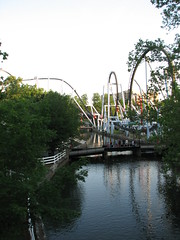 is not too fancy outside of the entry midway, it must be that they have a sizeable budget set aside to make sure everything in the park looks impeccably clean and well maintained. There’s rides and building everywhere, yet they are fully integrated into the landscape rather than built over it.
is not too fancy outside of the entry midway, it must be that they have a sizeable budget set aside to make sure everything in the park looks impeccably clean and well maintained. There’s rides and building everywhere, yet they are fully integrated into the landscape rather than built over it.
However, if there is one slight problem I have with the park as a whole, it’s that the coasters are all too short of experiences. Most parks of this size have that one (at least) ‘signature attraction’, whereas at Hershey, when I get to thinking what I want my big last ride of the night to be, there’s no clear answer to that. All of their coasters are short enough that two trains are all they need to service them (except for Fahrenheit and their single-car coasters, which is clear why more than two are needed on those rides). There’s no midcourse brakes, no minute-and-a-half long lifts that lead into a 4000ft+ layout; even their Arrow mine train, Trailblazer, a coaster style that’s notorious for featuring two or even three lifts at other parks, is a surprisingly brief ride experience here at Hersheypark. I think we got a seat in near the back of the train on our first true night ride of the evening, and even with the cool, quick skirts between the light next to Storm Runner and the darkness hidden behind a patch of trees, the experience still leaves much to be desired. Oh well, I’m feeling pretty good when I get off, maybe because this is the first evening that’s cooled off after the major heat wave from the past couple days, and Hersheypark is just so cool looking at night, and I know there’s way cooler things ahead.
Like Storm Runner. With less than a 5 minute wait, at night. The front row is singing to me. While waiting in the open air station I can see clearly the small orange spike on Fahrenheit, all lit up like a beacon between the dark trees and navy blue night sky, and I watch as several trains slowly crest the top.
Looks like operations are running quite smoothly over there, I can’t wait to get up close and see it all in person for the first time.
Fahrenheit fits the park quite naturally, showing it’s brightly colored twisted track all in clear view of the midway compared to the more conservatively colored, reclusive Storm Runner threaded through the woods and valleys of Pioneer Frontier across the way. It’s also centered perfectly along the main midway to the Midway America, creating a much needed pull in that direction away from the smaller side-loops that are home to all the other major coasters the park has so far (Storm Runner, Great Bear…) The queue unfortunately is probably so far Hershey’s least impressive, simple metal bars holding a chain link fence, narrowly shoehorned on a triangular plot of concrete in the infield of the station/brake/prelift area of the ride. Thankfully tonight there’s hardly a 10 minute wait to ride. Once again, front seemed the way to go.
Once again, front seemed the way to go.
The small, three-car train makes it’s way around the turn to the stretch of prelift track. There’s a slight pause as the two chains synchronize the catch dogs that push on the back of the train; this lift is actually more similar to Intamin’s cable elevator lifts than a traditional chain lift, especially in that it’s a perfectly silent, smooth ride up to the top. And wow, even though from the ground the vertical tower seems a bit too similar a concept to the slightly larger (but less steep on one end) red one across the midway, the experience of the slow approach only to be tipped all the way on your back (which I must say is not a natural sensation) starts the ride off on an entirely different and more curious note than Storm Runner’s more direct, wham-bam approach.
The first drop, okay, maybe a little disappointing compared to Maverick’s. While 2° ‘deeper’ (since ‘steepness’ technically maxes out once you hit 90°) than Maverick’s 95° drop, and 14 ft. higher, it has a much wider pull-over radius that makes the descent far less sudden and with more minor negative g’s, especially when experienced in the back. Still, when I compare the first lift/drop with other similarly styled looping coasters (such as Led Zeppelin’s straight-up-straight-down approach), Fahrenheit leaves them behind in the dust.
From here there’s a long pull out, featuring a moment’s pause in the pacing to enjoy the surge of speed up into my most anticipated single element,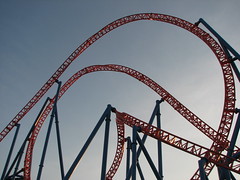 the Norwegian Loop. The slight tip to the right before diving left honestly doesn’t add much for me, and I was slightly surprised when I realized that despite how oddball and unique this element looks from the ground, when actually riding it… it’s just a dive loop. Okay, one with an extended lead-in and tighter twist at the top, but with the fact that the g-forces at the bottom of the loop, while strong, aren’t near the sustained 4-5g range I had been expecting, the Norwegian loop actually feels very traditional for a mega-looper, a dive loop leading into an Immelmann, some floater at the top, some forces at the bottom, nothing outside the range of pacing or intensity like it might lead one to expect.
the Norwegian Loop. The slight tip to the right before diving left honestly doesn’t add much for me, and I was slightly surprised when I realized that despite how oddball and unique this element looks from the ground, when actually riding it… it’s just a dive loop. Okay, one with an extended lead-in and tighter twist at the top, but with the fact that the g-forces at the bottom of the loop, while strong, aren’t near the sustained 4-5g range I had been expecting, the Norwegian loop actually feels very traditional for a mega-looper, a dive loop leading into an Immelmann, some floater at the top, some forces at the bottom, nothing outside the range of pacing or intensity like it might lead one to expect.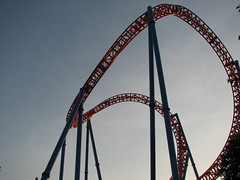
The cobra roll is sort of the dive loop turned inside out, and unfortunately there’s almost no snap into the rotation at the tops of the loops, and the middle bowl pullout is much too wide to get any good, interesting pacing, this element serves only to flip you upside down in a way that aims to be only moderately disorienting. Also, coming out of the cobra roll on every ride I had, there was some rather noticeable shaking. Come to think of it, Fahrenheit did suffer from an unfortunate case of vibrations throughout a lot of the ride (at least for being a new ride, and compared to Storm Runner), although only in the second half of the cobra roll did it stop being just a vibration and actually start jostling the riders around in their seats some. (On subsequent rides it was slightly scattershot where and to what degree the shaking would occur, but it was nearly always present.)
did it stop being just a vibration and actually start jostling the riders around in their seats some. (On subsequent rides it was slightly scattershot where and to what degree the shaking would occur, but it was nearly always present.)
Out of the cobra roll is another slight hesitation in the pacing as the track anticipates the sudden snap into the first corkscrew. Hate to break out the Maverick comparisons again, but the twists on Fahrenheit actually are corkscrews and not pseudo zero-g rolls with heavily curved entries. However, these corkscrews have a lot more spunk in them than any other corkscrews you’ll find around, with a very sharp, noticeable snap at the top of each,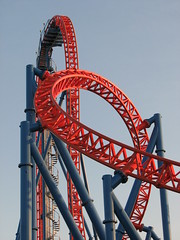 and a slight hesitation in the acceleration of the rolling at the bottom to nicely offset the snap at the top. In fact, I think these corkscrews are probably my favorite single elements on the entire ride.
and a slight hesitation in the acceleration of the rolling at the bottom to nicely offset the snap at the top. In fact, I think these corkscrews are probably my favorite single elements on the entire ride.
From the second corkscrew the pacing wastes no time into continuing to roll out into a tight, steeply pitched overbank that offers some pretty fast angular rotation as the cars cruise around it, twisting out and hitting a delicious pop of airtime in the small bunny that follows. This is immediately followed by a second curve in the opposite direction as the first  (and this one is just that, a curve, nothing more), and it then pulls up into an air-less crest into the magnetic brakes, although there is an odd little ‘counter-twist’ to be found in the heartline.
(and this one is just that, a curve, nothing more), and it then pulls up into an air-less crest into the magnetic brakes, although there is an odd little ‘counter-twist’ to be found in the heartline.
Getting off that first ride we still had about 10-15 more minutes until the park was scheduled to close, and the line had gone down even more since we first joined. Two more rides in the middle and back seat and we were done for the night, time to head out to our hotel which unfortunately was on the other side of Harrisburg.
So, was Fahrenheit what I was hoping for?
Not really. What I had been hoping for was a ride that put first and foremost an emphasis on pacing, and pacing that features both a perfect rhythmical symmetry but also dynamic progression throughout the ride experience. After the first surprise negative-g drop and extended lead-in to anticipate the Norwegian loop, I’d be hit with an element that mirrors itself, features lots of power but slightly slow pacing. From here it would progress into a tighter paced element, also offering the same two ‘notes’ mirrored against each other as the first element did. This would follow into a third set of two unique ‘notes’ following back-to-back, but the pacing has now increased to at least double the rhythm found in the first element. The ride would then end with a fast progression of two more sets of two (fast banked turns and airtime) to complement the first three sets of two found in the inversions, only these sets progress the pacing so the notes alternate with turn-air-turn-air (brakes), and the introduction of fast air at the end of the also will create symmetry with the air found at the beginning of the ride off the first drop, so that the entire experience has not only progressed in terms of quickening pacing but also come full circle. If I were to write this all out as a numerical pattern to illustrate what I’m describing it would be something like:
each other as the first element did. This would follow into a third set of two unique ‘notes’ following back-to-back, but the pacing has now increased to at least double the rhythm found in the first element. The ride would then end with a fast progression of two more sets of two (fast banked turns and airtime) to complement the first three sets of two found in the inversions, only these sets progress the pacing so the notes alternate with turn-air-turn-air (brakes), and the introduction of fast air at the end of the also will create symmetry with the air found at the beginning of the ride off the first drop, so that the entire experience has not only progressed in terms of quickening pacing but also come full circle. If I were to write this all out as a numerical pattern to illustrate what I’m describing it would be something like: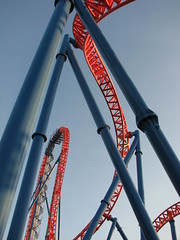
5… 1-1, 2-2, 3-3, 4-5-4-5
Get it?
Well, it didn’t actually work like that. For one, the final turn and rise into the brakes didn’t offer much so that final 4-5-4-5 pattern of progression I described above kind of falls apart, coupled with the fact that the Norwegian Loop and Cobra Roll don’t really have any pacing, they’re just there to turn you upside down in different ways like any other loops, the whole structure I was hoping for just isn’t there.
What I had instead was simply another mega-looper. That is, a mega-looper with a crazy lift and first drop, still pretty unique elements, and even several very strong pops of air that most certainly are not standard on most other mega-loopers I’ve been on (at least as long as B&M are still the chief supplier of your prototypical mega-loopers). And I’ll be damned if it still doesn’t give a hell of a ride and I even eventually realized it somewhere in my top 15 steel list. So all in all, you can toss this review into the pile of positives for Fahrenheit. It’s just not up there with Maverick.
if it still doesn’t give a hell of a ride and I even eventually realized it somewhere in my top 15 steel list. So all in all, you can toss this review into the pile of positives for Fahrenheit. It’s just not up there with Maverick.
Next: Hersheypark (pt. 2)
Previous: Dutch Wonderland
As an added bonus, if you have the NoLimits Roller Coaster Simulator you can enjoy this free download of my re-creation of Fahrenheit (click the image to the right).
I don’t know if this is the right spot for this, but you mention Maverick a lot. Do you have a review of Maverick anywhere?
Great Hershey review!
Hey Austin, this is as perfect a spot as any… seeing as, you are correct, there is no review for Maverick on this website yet. It’s one of my favorite rides at my home park, so that’s probably why it gets a lot of mention, but since it’s at my home park it’s ended up near the bottom of my “to-write” list, since I can go back and review it any time, whereas parks I have to travel to I want to write while they’re at least somewhat fresh. The problem is I’ve done so much traveling that I haven’t been able to get out from underneath my pile of “to-write” reviews since spring 2010, so rides like Magnum and Maverick have fallen by the wayside. Maybe 2013 will be the year I finally get caught up, who knows?
Not expecting a full review necessarily, but I am curious to hear your thoughts on Skyrush. I rode it in August 2012 and it actually became my favorite steel coaster (and favorite new coaster period on a trip that included Bizarro SFNE, Boulder Dash, El Toro, and Phoenix). I was surprised because I usually agree with your opinions on criteria like pacing, track length, and a strong finish, but Skyrush seems to break many of these “rules”, yet still landed in my #1 spot anyway. For me it was primarily the raw power, forces, and speed the ride possesses and never lets go of.
Yeah, unfortunately I can’t share your opinion on Skyrush, which is too bad because I really did want to like it. I think part of the problem was that the majority of the “raw power” and forces were felt on my upper thighs, even with the supposedly improved restraints. I could find ways to fight it or deal with it, but at that point I was putting too much mental concentration elsewhere than just enjoying the ride. Even beside that point, there wasn’t much in the layout that really interested me. I liked how, after the first half which has these drawn-out, one-dimensional (although strong) forces, after the Stengel dive it suddenly halves the rhythmic timing in the length between transitions with the back-and-forth weaving S-curves. But it doesn’t completely finish with this idea and hits the “finale” straight airtime hill what feels like an element or two too soon, and then wastes the actual final elements on a weak couple of hills that wander over the Comet back to the station. Probably the most unique feature of the ride for me was the big kink in the first drop where the radius suddenly tightens quicker than the gravitational trajectory, which causes the back rows especially to get an unexpected jolt of negative G’s.
I suspect the differences of opinion on Skyrush could also be a result of differences in physiology between riders where the restraint connects with their lap/thigh. Some people hate Arrow horsecollar restraints, but I find they always fit perfectly over my shoulders without banging my head at all, so I probably still enjoy Arrow coasters more than someone who isn’t my same height. It’s not really a “subjective difference”, but it is a difference in each person’s subjective encounter.
The Hershey Comet< AS DESIGNED by Herb Schmeck in 1946, and AS IT RAN in the 60's before Hershey Park became a theme-er, Hersheypark, was an excellent airtime filled coaster with element similar to the Phoenix (and it actually was a very slightly better ride including more airtime) than the Phoenix. The main problem now is a brake on the curve above the station which slows the ride to about half its normal speed so that the bunny hops on the T section are with virtually no air time and the turn around at the back of the T (used to sandwich you agsinst your riding partner before the days of seat dividers) has little in the way of laterals. A ride, once superior to the Phoenix is a mere shadow of itself.
The sad thing about many classic coasters like the Comet or (even more so) the Thunderhawk at Dorney Park is that their mediocre riding experience today is held up as an example of how much modern wood coaster design has improved over its predecessors, when in reality I think it’s gone backwards in a lot of ways, and it’s simply that all the once-greats are now merely imposters. Imagine what some of the old lame giants would be like today if they still ran like the Phoenix. Obviously I’ve never ridden the Comet in the 60’s, although I’d be skeptical that even at it’s best I’d prefer it to the Phoenix just because it’s a bit bigger and has some more forces. The mind-cleansing first tunnel and poetic arrangement of the hills and curves are both missing from the Comet’s layout, which to me, while more varied and unique, is also a lot more disorganized.
The best part of Hershey Park is the Fahrenheit load station that looks like a open air chapel. The rest of the park is so cool at night. When did you ride SkyRush? Could you explain the new restraints more and how they compare to opening season? Is it softer or contoured for your thighs now… I found the hardness and flatness of the original could be improved.
I rode SkyRush last year, after they replaced the restraints with softer padding. Haven’t been on it this year, though I’ve heard that not much has changed. As I recall the problem could have been easily corrected if they just shortened the length of the bar, so that when pulled down the flat side of the restraint would have rested more than two inches above the seat.
That’s a shame you didn’t like SkyRush, though it’s not really surprising considering the emphasis you place on sequencing of elements and the “narrative” a ride forms, whereas SkyRush really is all about forces for the sake of forces. Also, I don’t think you’ve ever complained about restraints on this website before (in fact you talk about liking some rides most others find uncomfortable), which should really say something to anyone who hasn’t ridden it. Definitely the first coaster that left me sore literally for days. While we’re on the topic, I’ve heard some enthusiasts state that SkyRush may be the most intense coaster ever built, and since you’re so well traveled I’m curious if you’d agree. I know “intensity” can be defined many ways, but if we’re talking in terms of pure physical force exerted on the body, does any other ride compare to SkyRush?
I wouldn’t say that I demand a good dramatic ride layout to like a ride; Storm Runner arguably has a much worse layout than Skyrush in that regard and it’s still in my top ten steel just because the few individual elements it has are all so amazing for me.
Skyrush was a combination of the restraints and the fact that the layout didn’t have very much that I found really interesting. I got the sense that the sum amount of sustained g-forces was quite a bit higher than most rides, but in terms of dynamic contrasts there’s not a whole lot happening except for a bit towards the end. In terms of “intensity” I would rank El Toro quite a bit higher, if only because it switches between dynamics a lot faster than Skyrush’s kind of shallow drawn-out transitions do. And as I would define “intensity”, Eejanaika and the second half of The Ultimate still take the cake over Skyrush by a long shot.